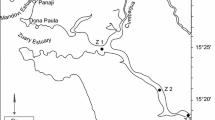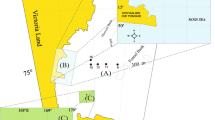Abstract
The response of benthos to sedimentation of the spring phytoplankton bloom in the Kiel Bight (Western Baltic Sea) is described in terms of biomass (ATP) and activity (heat production and ETS-activity). Input of the bloom (11.5 g C m-2) over a period from March 25 to April 19, 1980 to the sediment surface was in the form of cells and fresh phytodetritus as indicated by low C/N ratios (≦7) and high energy charge values (0.78). Benthic microbial activity was immediately stimulated by this input as heat production doubled and the activity of ETS tripled over winter values within 12 d in the absence of a significant increase in ambient temperature. A comparison of the two activity parameters suggests that anaerobic metabolism is more important during the winter (February and March) than after input of the bloom. Meiofauna was not able to take part in the first activity outburst. Benthic ATP-biomass (excluding macrofauna) doubled in late April due to microbial production, and doubled again in early May when meiofauna started reproductive activity. For macrofauna a general statement was not possible, although the sediment surface feeder Macoma baltica commenced a build up of glycogen and lipid resources immediately following bloom input whereas Nephtys ciliata, feeding on sediment and small macrofauna, showed a less pronounced and delayed effect from this input. An energy budget based on heat production measurements was calculated. A daily heat loss of the benthic community of 21.7 KJ m-2 d-1 (35.5 KJ m-2 d-1) was found, when a depth of 3 cm sediment (5 cm) was assumed. Heat production of macrofauna contributed less than 5% of this activity. The input of the bloom was “burned” within 21 (13) d. Preliminary estimations for an annual budget suggest that the vertical transport of particulate organic matter via sedimentation can only explain 25% (15%) of the benthic activity in the shallow water ecosystem of the Kiel Bight. This indicates the presence of other sources of organic carbon such as benthic primary production or other transport processes providing carbon to the sediments.
Similar content being viewed by others
Literature Cited
Arntz, W. E.: Zielsetzung und Probleme struktureller Benthosun-tersuchungen in der marinen Ökosystemforschung. Verh. d. Gesellsch. f. Ökologie, 35–51, Kiel (1978)
Black, H.: Vegetationsdynamische Untersuchungen an epilithischen Algengemeinschaften im Sublitoral der westlichen Ostsee unter besonderer Berücksichtigung des Problems der produktionsbiologischen Bestandsabschätzung. Ph. D. thesis, Kiel University, 205 pp. 1978
Cederwall, H.: Energy flow and fluctuations of deeper soft bottom macrofauna communities in the Baltic Sea. Ph. D. thesis, Stockholm, 23 pp. 1979
Chapman, A. G., L. Fall and D. E. Atkinson: Adenylate energy charge in Escherichia coli during growth and starvation. J. Bacteriol. 108, 1072–1086 (1971)
Christensen, J. P. and A. H. Devol: Adenosine triphosphate and adenylate energy charge in marine sediments. Mar. Biol. 56, 175–182 (1980)
Dold, R.: Zur Ökologie, Substratspezifität und Bioturbation von Makrobenthos auf Weichböden der Kieler Bucht. Ph. D. thesis, Kiel University, 456 pp. 1980
Erlenkeuser, H.: Stable carbon isotope characteristics of organic sedimentary source materials entering the estuarine zone. Biogeochem. of estuarine Sediments. Proceedings of an Unesco/SCOR workshop, Melreux/Belgium, 29. Nov.-3. Dez. 1976, 199–206, Unesco, Paris 1978
Ernst, W.: ATP als Indikator für die Biomasse marine Sedimente. Oecologia 5, 56–60 (1970)
Gerlach, S. A. and M. Schrage: Life cycles in marine meiobenthos. Experiments at various temperatures with Monhystera disjuncta and Theristus pertenuis (Nematoda). Mar. Biol. 9, 274–280 (1971)
Gnaiger, E.: Das kalorische Äquivalent des ATP-Umsatzes im aeroben und anoxischen Metabolismus. Thermochim. Acta 40, 195–223 (1980)
Graf, G.: Energy-Charge-Messung im marinen Benthos. Ph. D. thesis, Kiel University, 121 pp. 1979
Graf, G. and G. Lagaly: Interaction of clay minerals with adenosine-5-phosphates. Clays Clay Miner. 28, 12–18 (1980)
Graf, G., L.-A. Meyer-Reil, G. Liebezeit, R. Dawson and A. Faubel: Adenylate energy charge of sandy beach sediments and its relation to free dissolved organic compounds. (In preparation)
Handel, E. van: Estimation of glycogen in small amounts of tissues. Analyt. Biochem. 11, 256–265 (1965)
Holler, B.: Zur Messung von Energy Charge und Wärmeproduktion wichtiger Komponenten der marinen Benthosgemein-schaft. M. S. thesis, Kiel University, 86 pp. 1980
Holm-Hansen, O. and H. W. Paerl: The applicability of ATP determination for estimation of microbial biomass and metabolic activity. Mem. 1st Ital. Idrobiol. 29 (Suppl.), 149–168 (1972)
Iturriaga, R. and H.-G. Hoppe: Observations of heterotrophic activity on photoassimilated organic matter. Mar. Biol. 40, 101–108 (1977)
Ivlev, V. S.: Eine Mikromethode zur Bestimmung des Kaloriengehalts von Nährstoffen. Biochem. Z. 275, 51–55 (1934)
Karg, S.: Vergleichende Produktivitätsuntersuchungen am Mikrophytobenthos in der Kieler Förde. M. S. thesis, Kiel University, 73 pp. 1979
Karl, D. M. and O. Holm-Hansen: Methodology and measurements of adenylate energy charge ratios in environmental samples. Mar. Biol. 48, 185–197 (1978)
Kölmel, R.: Ökosysteme im Wechsel zur Anaerobiose. Die Entwicklung von Zoobenthos und Abbau in zeitweise anoxischen Biotopen der Kieler Bucht. Ph. D. thesis, Kiel University, 403 pp. 1976
Lenz, J.: Seston and its main components. In: Ecological studies 25, Microbial ecology of a brackish water environment, pp 39–60. Ed. by G. Rheinheimer. Berlin: Springer Verlag 1977
Meyer-Reil, L.-A.: Enzymatic decomposition of proteins and carbohydrates in marine sediments: methodology and field observations during spring. Kieler Meeresforsch., Sonderh. 5, 311–317 (1981)
Mills, E. L.: Benthic organisms and the structure of marine ecosystems. J. Fish. Res. Bd. Can. 32, 1657–1663 (1975)
Neuhoff, H.-G.: Effects of seasonally varying factors on a Nereis succinea population (Polychaeta, Annelida). Mar. Ecol. Prog. Ser. 1, 263–268 (1979)
Oertzen, J.-A. von: Cycles and rates of reproduction of six Baltic Sea bivalves of different zoogeographical origin. Mar. Biol. 14, 143–149 (1972)
Pamatmat, M. M.: Oxygen uptake and heat production in a metabolic conformer (Littorina irrorata) and a metabolic regulator (Uca pugnax). Mar. Biol 48, 317–325 (1978)
Pamatmat, M. M.: Facultative anaerobiosis of benthos. In: Marine benthic dynamics, pp 69–90. Ed. by K. R. Tenore and B. C. Coull. Columbia: University South Carolina Press, 1980
Pamatmat, M. M., G. Graf, M. Bengtsson and C. S. Novak: Heat production, ATP concentration and electron transport activity of marine sediments. Mar. Ecol. Prog. Ser. 4, 135–143 (1981)
Parsons, T. R., M. Takahashi and B. Hargrave: Biological oceanographic processes, 2nd ed., 322 pp. Oxford: Pergamon Press 1977
Peinert, R., A. Saure, P. Stegmann, C. Stienen, H. Haardt and V. Smetacek: Dynamics of primary production and sedimentation in a coastal ecosystem. Neth. J. Sea Res. Proceedings of the 16th EMBS Texel 1981, (In press)
Pollehne, F.: Die Sedimentation organischer Substanz, Remineralisation and Nährsalzrückführung in einem marinen Flachwasserökosystem. 149 pp. Ph. D. thesis, Kiel University 1980
Salonen, K. J., J. Sarvala, I. Hakala and M.-L. Kiljanen: The relation of energy and organic carbon in aquatic invertebrates. Limnol. Oceanogr. 21(5), 724–730 (1976)
Scheibel, W.: Submarine experiments on benthic colonization of sediments in the western Baltic Sea. II. Meiofauna. Mar. Biol. 28, 165–168 (1974)
Scheibel, W.: Zur Nahrung von Nephtys ciliata (O. F. Müller, 1976) (Polychaeta, Nephtyidae) aus der westlichen Ostsee (Kieler Bucht). Zool. Anz. Jena 206 314, 171–177 (1981)
Skjoldal, H. R. and U. Båmstedt: Ecobiochemical studies on the deep-water pelagic community of Korsfjorden, western Norway. Adenine nucleotides in zooplankton. Mar. Biol. 42, 197–211 (1977)
Smetacek, V.: Annual cycle of sedimentation in relation to plankton ecology in western Kiel Bight. Ophelia 1, Suppl., 65–76 (1980)
Smetacek, V., K. von Bröckel, B. Zeitzschel and W. Zenk: Sedimentation of particulate matter during a phytoplankton spring bloom in relation to the hydrographical regime. Mar. Biol. 47, 211–226 (1978)
Smetacek, V. and P. Hendrikson: Composition of particulate organic matter in Kiel Bight in relation to phytoplankton succession. Oceanol. Acta 2, 287–298 (1979)
Witzel, K.-P.: The adenylate energy-charge as a measure of microbial activities in aquatic ecosystems. Arch. Hydrobiol., Beih. Ergebn. Limnol. 12, 146–165 (1979)
Author information
Authors and Affiliations
Additional information
Communicated by O. Kinne, Hamburg
Publication No. 384 of the Joint Research Program of Kiel University (Sonderforschungsbereich 95)
Rights and permissions
About this article
Cite this article
Graf, G., Bengtsson, W., Diesner, U. et al. Benthic response to sedimentation of a spring phytoplankton bloom: Process and budget. Marine Biology 67, 201–208 (1982). https://doi.org/10.1007/BF00401286
Accepted:
Issue Date:
DOI: https://doi.org/10.1007/BF00401286




